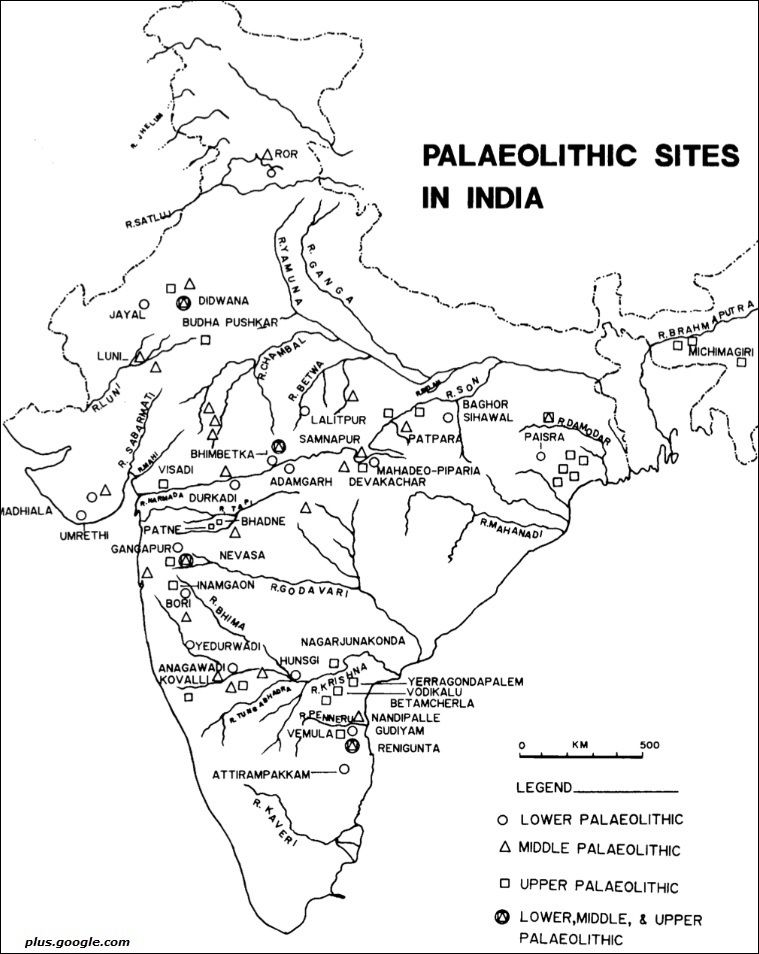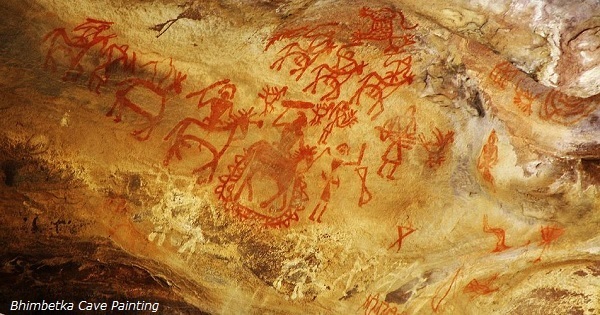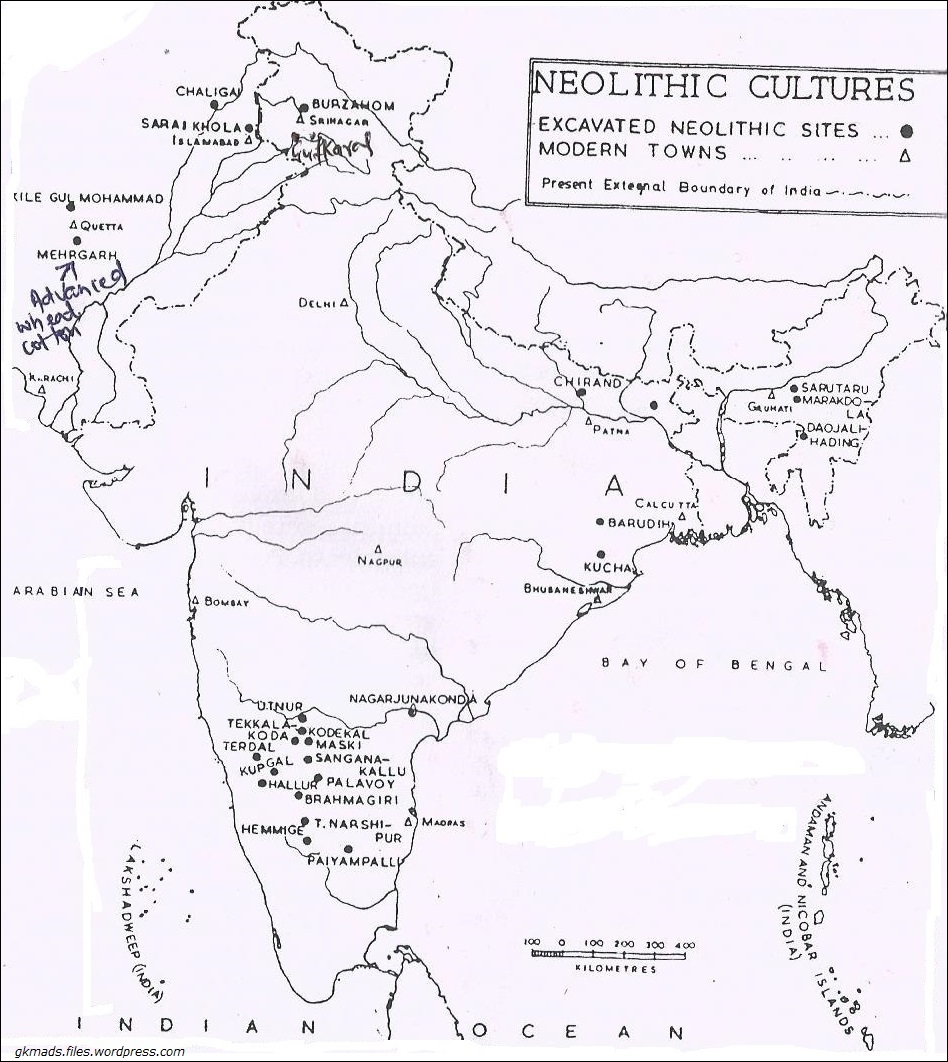Stone Age
Only Fossils cannot be considered an authentic element to know about prehistoric mankind. To unravel the ancient mystery, one usually has to rely on tools made of stone metal, and other materials. It can be said that primitive people came to prove their existence on Earth from 2,50,000 BC onwards.
A vast prehistoric era known as the Stone Age witnessed the widespread usage of stone to create tools having an edge, a point, or a percussive surface. With the invention of metalworking, the roughly 3.4 million-year-long period came to an end between 4,000 and 2,000 BC.
At the other end of the spectrum, based on the current evidence from the village Bori of Maharashtra, the first mankind in India was extinct approximately 1.4 million years ago. Later, mankind made various types of tools (weapons) using stone around 3000 BC. As a result, that period is called the Stone Age.
Classifications of Stone Age
The Stone Age is further divided into three parts, namely,
- Paleolithic age (5,00,000 BC – 25,000 BC) – also known as Old Stone Age
- Mesolithic age (10,000 BC – 5,000 BC) – also known as Middle Stone Age
- Neolithic age (5,000 BC – 2,500 BC) – also known as New Stone Age
However, Scholars have divided the ancient period into three parts based on the evolution of the script.
- Pre-History: Written materials are not found at this time.
- Proto-History: Written materials were found at this time but not possible to decipher them. Example: Harappa civilization.
- History: Written materials were found at this time and can be deciphered. Ex: Vedic civilization. Example: Vedic age.
Paleolithic age (5,00,000 BC – 25,000 BC)
Key characteristics of the Paleolithic Age:
- Hunter-Gatherer Lifestyle: Paleolithic Age humans hunted animals for food, clothing, tools, and collected plants, fruits, nuts, seeds, etc.
- Use of Stone Tools: Paleolithic Age consists of the development of stone tools like handaxes, scrapers, spear points, and knives for hunting and other tasks.
- Nomadic Lifestyle: Paleolithic societies were nomadic, moving for food and resources, following animal migration patterns and plant availability.
- Simple Social Structures: Early humans lived in small groups, cooperative for hunting, protection, and resource sharing.
- Primitive Art and Symbolism: Early art and symbolism, including cave paintings, carvings, and sculptures, indicate human creativity and expression.
- Control of Fire: Later Paleolithic Age humans developed fire control for cooking, warmth, and protection.
- Adaptation to Changing Environments: Paleolithic Age humans adapted to climate shifts by finding food and shelter strategies.
- Limited Technology: Limited technology and stone tools were crucial; humans didn’t develop agriculture, with permanent settlements.
The Paleolithic age in India began with the Ice Age. The presence of humans in the primitive period of the motherland ended in 500,000 BC. In this age, mankind used to collect food and hunt wild animals. They also used to take fruits and vegetables from the forest as food.
The tools of stone used by humankind in this age were largely uneven. They lived in caves or simple huts. Besides, they had no idea about agriculture, fire, pottery, and other things.
In this age, humankind generally used tools/weapons like hand-ax, ax, chopper, blade, hoe, etc. Such tools they made mainly from stone or quartzite or bones. That is why the people of the Paleolithic Age are called ‘quartzite men‘.
Lifters and needles were used during this period. These tools had been obtained from Andhra Pradesh, Karnataka, Maharashtra, Bhopal, and Chota Nagpur Plateau.
According to Tim Dyson-

In the last phase of this age, we first see the existence of the Homocepians in the human race. It can be said that the Paleolithic peoples of the Stone Age belonged to the Negrito tribe. The Paleolithic Age in India is basically divided into three parts. This division was dependent on the proximity of the tools of stone to climatic change. These three distinctions are — the Lower Paleolithic Age, the Middle Paleolithic Age, and the Upper or Last Paleolithic Age.
In this age, humans used hand-ax, ax, and chopper. All these tools were found in the Sayan Valley (now in Pakistan) and the Belan Valley (now in Mirzapur District in Uttar Pradesh). Some important places of this era are Sayan Valley, Narmada Valley, and Tungabhadra river valley.
The climate of the Paleolithic age was changed due to humidity. Later the climate become dry and warm.

Decline of Paleolithic Age: The transition from a nomadic, hunter-gatherer lifestyle to permanent farming and the domestication of plants and animals marked the end of the Palaeolithic Age and the start of the Neolithic Revolution. The Neolithic Age and the subsequent development of more complex societies were made possible by this transition.
Mesolithic age (10,000 BC – 5,000 BC)
Key Characteristics of the Mesolithic Age
- Emergence of Microliths: The Mesolithic Age witnessed the widespread use of microliths, small, finely crafted stone tools for hunting and cutting, enabling greater precision and versatility in tool-making.
- Shift towards Sedentism: Mesolithic groups transitioned from nomadic to settled lifestyles, benefiting from stable food sources, particularly in coastal areas and river valleys.
- Variety of Food Sources: Mesolithic humans diversified their diet, utilizing land animals, marine life, fish, and aquatic creatures, leading to more complex societies.
- Seasonal Settlements: Mesolithic communities established seasonal settlements near water sources and wildlife, relocating based on resource availability.
- Use of Natural Shelters: Mesolithic people utilized natural rock shelters for temporary living, protection, and various activities, unlike Paleolithic cave art.
- Limited Agricultural Practices: Mesolithic regions experimented with plant cultivation, but agriculture wasn’t dominant until Neolithic Age.
Between the Palaeolithic and Neolithic Ages is the Mesolithic Age, commonly referred to as the Middle Stone Age. Generally speaking, it lasted from around 10,000 BCE to around 6,000 BCE, though specific dates may vary based on the location. As people continued to adapt to shifting surroundings and resource availability, the Mesolithic Age is seen as a period of incremental changes in human cultures and technologies.
The climate of this era was basically dry and hot. The tools/weapons of this era were basically miniature. These tools were originally made from stone. In this age, mankind made a living by hunting, fishing, and gathering food.
Later, however, people domesticated wild animals. In addition, they adopted agricultural plans. Some famous historical sites of this period are the Chota Nagpur Plateau, Central India, and the south bank of the Krishna River.

The Mesolithic Age prepared the way for the major transformations that would take place during the Neolithic Revolution. Communities started experimenting with cultivation and animal domestication as they became more established and learned how to use a larger variety of resources, which indicated a change to a more agricultural way of life. In the end, this transition resulted in the growth of more advanced communities with long-term habitations.
Neolithic age (5,000 BC – 2,500 BC)
Key characteristics of the Neolithic Age
- Agriculture and Domestication: Neolithic Age saw the emergence of agriculture, with humans cultivating plants and domesticating animals, leading to settled communities and agriculture-based economies.
- Permanent Settlements: People established permanent settlements for agriculture, crops, and livestock, enabling larger populations and complex social structures in fertile areas.
- Surplus Food Production: Agricultural practices enabled surplus food production and storage.
- Craft Specialization: Neolithic societies experienced craft specialization, focusing on pottery, weaving, tool-making, and construction, enhancing life quality through various goods.
- Development of Technology: Neolithic Age saw technological advancements in stone tools, pottery, and agriculture, enabling diverse activities and refinement.
- Social Stratification: Complex societies grew, introducing social stratification, roles, and chiefs to manage communal affairs.
- Religious and Ceremonial Practices: Neolithic societies practiced religious and ceremonial rituals related to agriculture, fertility, and seasonal changes, exemplified by megalithic monuments like Stonehenge.
- Expansion of Trade and Communication: Neolithic communities’ surplus resources and crafts facilitated trade networks.
The beginning of agriculture was one of the Neolithic Age’s most significant developments. Plants like wheat, barley, and legumes as well as domesticated animals like goats, sheep, cattle, and pigs were first purposely grown by humans. This transition from relying on wild resources to raising their own food led to the rise of established populations and economies based on agriculture.
The Neolithic Age never occurred in India before 4,000 BC. The beginning of this period was observed in some parts of South and East India around 500 BC. Even in the Neolithic Age, people generally made tools with stone; the tools were smooth, sharp, polished, and lethal.
In the Neolithic Age, humans had learned to cultivate. That was the beginning of agriculture. The grain they produced were Barley, buckwheat, ragi, and oats.
The mankind of this age also used to graze domestic animals such as sheep and goats.
People of this age were the first to use the fire. They also learned to make pottery with a potter’s wheel. In addition, they used to draw various pictures on pottery. In the caves where Neolithic humans lived, images of dancing and hunting were also observed.
During this period they made cloth from cotton. Including this Neolithic people had the knowledge of the construction of boats.
In the later stages of the Neolithic Age, they developed a more advanced human life. In addition, they built some round and rectangular houses with soil and plants.
Some famous Neolithic historical sites are Burzahom in Jammu and Kashmir, Maski, Tekkalakota (Andhra Pradesh), Paiyampalli in Tamil Nadu, Chirand in Bihar and Senuar, Amri, etc.

Comparison of Paleolithic Mesolithic & Neolithic Age
| Paleolithic age | Mesolithic age | Neolithic age |
|---|---|---|
| Neolithic people used to draw & design on the walls of the caves. Stone tools/weapons they used were smooth, delicate, and effective. | The Mesolithic civilization in India arose from 25,000 to 5,000 BC. | Neolithic civilization developed in India between 5,000 and 3,000 BC. |
| People mainly practiced hunting and collecting food. | People hunted fish with their animals and food. | Neolithic people used to cultivate their own food. |
| People lived in caves and used uneven, blunt stone tools/weapons | The tools they used were more efficient than ever before. | The climate is similar to the climate of the present age. |
| At this age, the climate was covered with snow. | The climate began to be relatively warm and dry. Flora and fauna originated at this time. | The climate was similar to the climate of the present age. |
The end of the Stone Age is marked by the melting and smelting of copper, even though some primitive metalworking of malleable metals—particularly the use of gold and copper for ornamentation—was known during that time. This started to happen in Western Asia in 3,000 BC when bronze became widely used.
Pre-history of India general knowledge notes for competitive government job examinations such as UPSC, IAS, SSC, CGL, Banking, Railway public service commission PSC for state levels.
